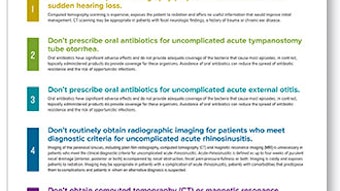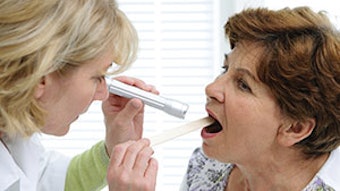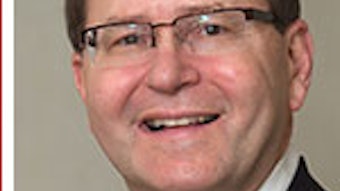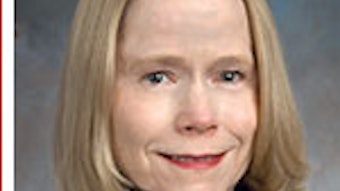VoiceSocial media is no competition for the human voice
Social media is no competition for the human voice By J. Ongkasuwan, MD, assistant professor at Baylor College of Medicine, Houston, TX, for the AAO-HNS Voice Committee The theme for World Voice Day 2015 is “Voice: The Original Social Media.” So what is social media? The Merriam-Webster online dictionary defines social media as “forms of electronic communication through which users create online communities to share information, ideas, personal messages, and other content.”
By J. Ongkasuwan, MD, assistant professor at Baylor College of Medicine, Houston, TX, for the AAO-HNS Voice Committee
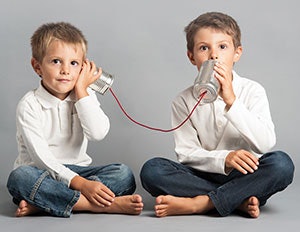
A decade later, social media permeates all facets of our lives private and public: from your private Facebook account where you share family photos, to your public Facebook account where you can attract patients, to your otolaryngology practice profile page. Institutions, including ivory tower academic ones, can have entire departments dedicated to crafting their online presence, maintaining blogs, vlogs, and patient information portals. All this content is directed to those of us who are glued to the screens in front of us, our hands constantly groping for our smartphone with a Pavlovian response to the ding of a notification.
Find out more about World Voice Day at www.entnet.org/WorldVoiceDay. Members and their staff will find poster and health information including the “Smart-Talk” items from page 17 to use in office at this online resource. Make sure to download the poster and tips to observe World Voice Day. Don’t forget to share these tools with your referring physicians as well.
As exhilarating as all of this connectivity is, does liking a high school friend’s status update about his or her son’s baseball game equate to a phone call to catch up? Handwringing abounds about teens sitting next to one another choosing to text instead of talk and are only able to type in unpunctuated shorthand (IMHO). Like an online dating profile, we edit and construct an image to present to the online world—but does it truly represent us? How reliable is the information that is propagated through social media? Outliers and fanatics can have as broad a platform as credible data supported organizations. The anonymity of online forums can bring out the most ignoble human behaviors and the trolls.
Recent popular culture is rife with social media missteps. Errant tweets have ruined political careers. Ill-conceived marketing campaigns have resulted in embarrassing publicity for major corporations.2 Young physicians, who have grown up inured to constant sharing of their lives on Facebook, Twitter, and Instagram, have had to learn the hard way about the Health Insurance Portability and Accountability Act (HIPAA) and patient privacy. Hospitals employ individuals to police social media for mentions of their institutions. How many of us now get sign out or updates on a patient via a text? How much information about a sick patient can be conveyed in 200 characters? In the interim, medical and legal institutions scramble to keep up with the changes in technology and their implications for patient care and privacy.
Despite these changes, this online universe still has yet to supplant the old-fashioned phone call or face-to-face conversation. We still fly across the country to sit in a conference room to present and talk to one another. Laboratory groups still have weekly meetings to discuss projects. Hospitals still have grand round presentations and departmental meetings. Although many medical school lectures are now recorded and online, students still have to show up before dawn for clinical rotations. Patients still get in their cars and drive, sometimes hours, to our offices to see us. Online patient access to records and advice can help with communication over trivial matters; however, sensitive information is best conveyed via a phone call or, better yet, face-to-face. To do otherwise is considered inappropriate, cold, rude, or gauche. While disease support group pages can be invaluable to patients, it can be difficult to wade through the volumes of information and disinformation on the Internet. Patients often look to us, medical professionals, to help them sort through the cacophony.
Via inflections and emotions, voice can impart a much clearer and nuanced message than a tweet. President Franklin D. Roosevelt knew this, using his 1930s radio “fireside chats” to woo U.S. citizens.3 Although they hire young idealists to manage their social media presence, politicians still use verbal argument and presentation to convince individuals of their sincerity and political goals. In 2007, the video of Dr. Randy Pausch’s last lecture at Carnegie Mellon University, after his diagnosis with terminal pancreatic cancer, had a powerful emotional influence on people worldwide. Nothing can replace the connection forged by a warm reassuring smile, handshake, and “Hi, I’m Dr. X. What brings you in to see me today?” While social media is flexing its muscles as a fresh and powerful tool, ergo the Arab Spring, the voice remains the original social media.
References
- Bercovici J. Who coined ‘social media’? Forbes. Dec. 9, 2010. http://www.forbes.com/sites/jeffbercovici/2010/12/09/who-coined-social-media-web-pioneers-compete-for-credit/. Accessed Nov. 25, 2014.
- Wagner M. Corporate social media fails of 2014: big brands make big mistakes. New York Daily News. Dec. 20, 2014. http://www.nydailynews.com/news/national/biggest-corporate-social-media-fails-2014-article-1.2051168. Accessed Jan. 15, 2015.
- http://en.wikipedia.org/wiki/Fireside_chats. Accessed Nov 25, 2014.
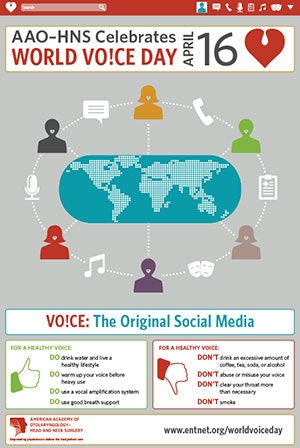
Share these tips with your patients and spread the word about the importance of a healthy voice. Visit www.entnet.org/worldvoiceday to print your 2015 poster and access other World Voice Day resources.
- Go to entnet.org/worldvoiceday to access the high-resolution print file.
- Choose a size: small (11.75” x 17.3”), medium (18” x 24”), large (24” x 36”)
- Upload to your local office supply store’s website or save the file and take it to the store for printing.
- Display in your office!
Here are a few vendors you may choose from:
- print.staples.com/posters.aspx
- customprinting.officedepot.com
- or try your drug store as well.
